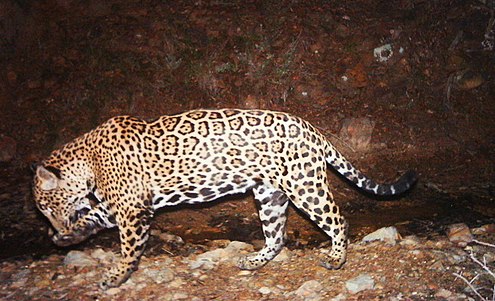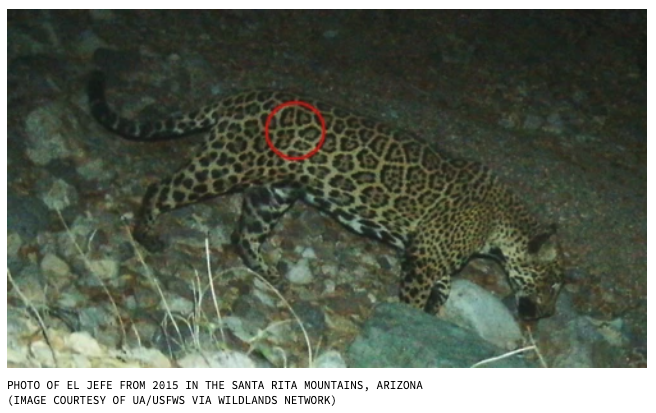advertisement
15 August 2022

One of the most extraordinary things about Arizona is its remarkable biodiversity. The Sonoran Desert is home to nearly 3,500 plant species, 500 bird species, and 1,000 bee species. As a result of the state’s elevation difference of 12,563 feet, Arizona has an incredibly diverse ecological environment. One more notable species is the North American jaguar El Jefe, or “The Boss.”
advertisement
El Jefe was photographed in the Whetstone Mountains in 2011 by Donnie Fenn and his 10-year-old daughter, who were out hunting with their hunting dogs who chased El Jefe up a tree. Fenn took photographs of the jaguar and contacted state wildlife officials later.
El Jefe was a miraculous find — he represented the only verified jaguar living in the United States, where they once ranged throughout the southwest.
Jaguars historically thrived in western Texas, Arizona, and New Mexico. Jaguars, however, have been confined to southern parts of these states since the 1940s. Because of their march towards extinction, Defenders of Wildlife sued the US Fish and Wildlife Service in 2010 to recover jaguars and designate “Critical Habitat.” In the United States, Fish and Wildlife Service has designated the Santa Rita mountains as critical habitat for species recovery.

advertisement
Spottings of El Jefe went dark in 2015, but last year he was spotted in Sonora, Mexico, researchers confirmed recently, reviving hopes that the species can evade the border wall that bisects its habitat.
El Jefe’s disappearance remains a mystery, primarily since it occurred around the time Donald Trump began building his border wall. Conservationists immediately opposed the border wall, claiming the wall threatened myriad species like Mexican wolves, bison, and ocelots, including endangered jaguars like El Jefe.
To help save the jaguar, you can donate to Greatergood.org or sign up for alerts at Defenders of Wildlife.
advertisement
The saguaro cactus (Carnegiea gigantea) is one of the most iconic symbols of the American Southwest, and for good reason. These towering cacti are found primarily in the Sonoran Desert of Arizona, California, and Mexico, standing tall and proud with their arm-like branches reaching toward the sky. While most people are familiar with the saguaro cactus thanks to Western films and desert landscapes, there are several fascinating facts that many may not know about this unique plant. Here are some intriguing facts about saguaro cacti that may surprise you! advertisement 1. They Can Live Over 150 Years Saguaro cacti are
Arizona is a hiker’s paradise, whether you’re a seasoned adventurer or a casual weekend explorer, the state has a trail for every style, season, and skill level. Here are some of the best places to hike in Arizona. advertisement 1. Cathedral Rock – Sedona Difficulty: Moderate to strenuous Why It’s Amazing: This iconic red-rock formation offers one of Sedona’s most breathtaking climbs. The trail is steep, hands-on, and rewarding with unforgettable panoramic views. 2. Camelback Mountain – Phoenix Difficulty: Strenuous Why It’s Amazing: One of the most famous urban hikes in the country, Camelback delivers challenging scrambles, busy energy, and
When most people picture Arizona, they imagine cactus-filled deserts and blazing summer heat. But head north or climb in elevation, and a completely different side of the state appears: powdery snow, pine forests, cozy cabins, and ski runs with sweeping mountain views. Arizona’s snowy adventures offer a surprising winter escape for travelers who want chill instead of sizzle. advertisement Where to Find Snow in Arizona Snow in Arizona is all about elevation. The higher the climb, the better the chance of a winter wonderland. Northern and eastern Arizona are the prime regions for cold-weather fun, with pine-covered plateaus and mountain
Arizona, with its impressive diversity, surprises newcomers and constantly defies stereotypes. While many people picture endless deserts, triple-digit temperatures, and sunburn as far as the eye can see, the reality is far more varied. Here are the top 10 misconceptions about Arizona, and the truth behind them. advertisement 1. Arizona Is Just a Hot, Dry Desert Most people imagine the entire state melting under 115°F heat. And while parts of Arizona (like Phoenix and Yuma) are famously sizzling, the state also has snow-covered mountains, forests, alpine lakes, and ski resorts. Flagstaff, for example, sits at around 7,000 feet in altitude
advertisement
| Cookie | Duration | Description |
|---|---|---|
| cookielawinfo-checkbox-analytics | 11 months | This cookie is set by GDPR Cookie Consent plugin. The cookie is used to store the user consent for the cookies in the category "Analytics". |
| cookielawinfo-checkbox-functional | 11 months | The cookie is set by GDPR cookie consent to record the user consent for the cookies in the category "Functional". |
| cookielawinfo-checkbox-necessary | 11 months | This cookie is set by GDPR Cookie Consent plugin. The cookies is used to store the user consent for the cookies in the category "Necessary". |
| cookielawinfo-checkbox-others | 11 months | This cookie is set by GDPR Cookie Consent plugin. The cookie is used to store the user consent for the cookies in the category "Other. |
| cookielawinfo-checkbox-performance | 11 months | This cookie is set by GDPR Cookie Consent plugin. The cookie is used to store the user consent for the cookies in the category "Performance". |
| viewed_cookie_policy | 11 months | The cookie is set by the GDPR Cookie Consent plugin and is used to store whether or not user has consented to the use of cookies. It does not store any personal data. |
